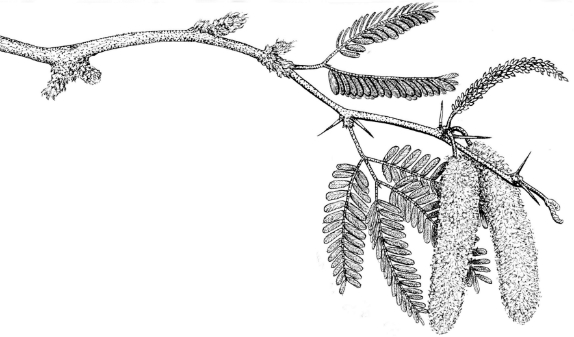
The Velvet Mesquite
May 3, 2017Consider the mesquite tree. Mesquites are not merely trees; they create a whole ecosystem. Grubs nibble at their roots. Borers live inside the trunk, and if visible, their pathways would be seen as a beautiful network of engraved tunnels with insect woodcarvers at the ends. The long (3”-5”) catkins of tiny yellow flowers, visited by bees, wasps, flies and beetles, are followed by sweet pods which are food to rodents, rabbits, birds, coyotes, deer and people. Phainopeplas plant their crop of mistletoe upon its branches, to later enjoy the berries. A beetle called the mesquite twig girdler cuts a perfect groove around pencil-sized twigs, naturally pruning and smoothing the outline of the tree. Beautiful black and yellow mesquite bugs suck the sweet sap from growing pods. Bruchid beetles grow up inside mesquite seeds, leaving telltale pinholes in the pods as they exit. A hornworm, with extra rows of spines on its head, eats the leaves. Rust and other tiny fungi live on the leaves, and rhizobium bacteria grow upon the roots, trading fixed nitrogen for sugar from the tree. Mesquite is more than a plant – it is a city.
Mesquite is a lover of water and a seeker of depth, growing best near washes and streams. Under favorable conditions, mesquite roots can penetrate to great depths — roots were pulled out with ore at the 400-foot level of the San Manuel mine in the 1970’s — and trees on droughty upland sites are usually stunted and shrubby.
The name mesquite is believed to be Aztecan in origin. To native peoples, mesquite was manna (a stable source of food even in times of famine), timber for homes, wood for heat, fiber for baskets and shade from the blazing desert sun.
The new peoples (settlers) used mesquite for lumber and fuel, and cursed it as a weed when it grew in the places where their cattle had destroyed the grasses. Prior to grazing, frequent grass fires had limited mesquite to the wetter habitats. Only now is it slowly being understood that the mesquites have a greater economic value per unit of land than the beef that could be produced if the trees were eliminated.
Mesquite firewood is valuable, imparting a distinctive flavor to meat and vegetables cooked over it, and it burns with a clean, blue flame. Soaking the pods in water and putting them in the fire achieves the same effect in a more environmentally sound manner. Chocolate-colored mesquite lumber sells for a price higher than that of black walnut, usually wholesaling for $4-10 per board foot. Mesquite honey is light-colored and of high quality, comparing favorably with that of clover and alfalfa.
Velvet mesquite is a beautiful, brown-crowned tree, with heavily textured grey-grown bark and undulating arching branches with minutely hairy, blue green leaves. It can grow 60 feet tall, 100 feet wide and up to 6 feet in diameter.
Prosopis usually grows in groves and ranges from the North American great plains to South America, and from sea level to about 5,000; elevation. Mesquite is truly the tree of life in the Sonoran Desert.

